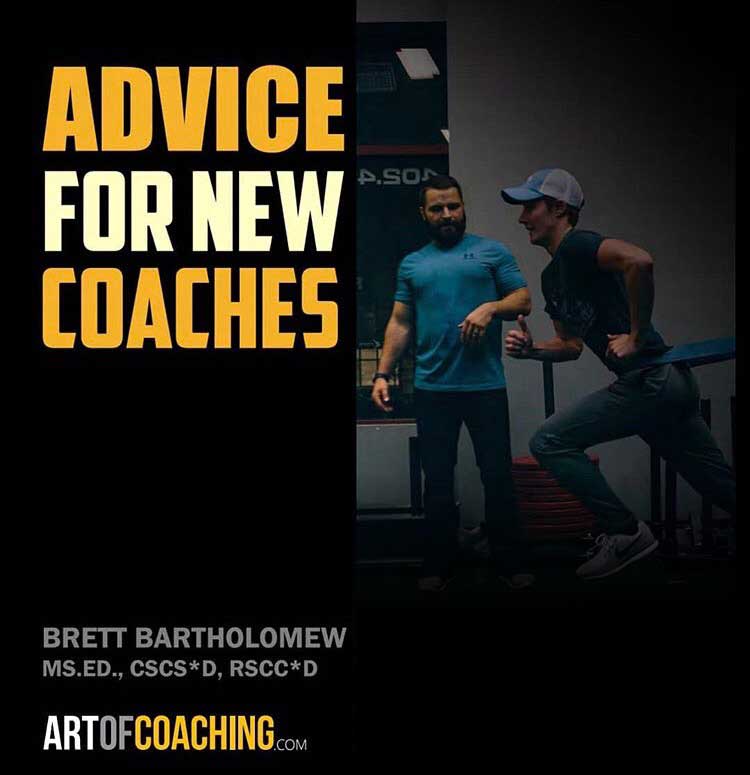Last week I received a question from a coach who recently found themselves in a position where they were now in charge of coaching larger groups (20+) than they ever have been before. They were confident, but also concerned stating that they often found themselves rushing their words, slipping up in their cues, and rushing back and forth to make sure nobody went un-coached in some capacity. They later admitted that they believed nerves to be the culprit for their erratic behavior, and that these nerves were made worse since under normal circumstances (for them), where they coach 5–10 athletes, they have no issue whatsoever and rarely get out of rhythm in regards to what they do or how they do it.
In other words, once their group size doubled so did their level of self-doubt and anxiety.
It’s important to first acknowledge that for a coach, a certain level of anxiety is normal and even healthy. Many of us are brought up to believe that feeling anxious is a weakness, and that we need to instead puff out our chest and cultivate a sense of bravado that permeates a room and those in it. Nothing could be further from the truth.
The error in this train of thought is that many people confuse anxiety with being nervous, yet there is a clean and clear distinction between the two. Nervousness is something you feel when you are unprepared, anxiety is something you feel when you care about what you are doing so much, that the emotions you feel often override the critical thought processes which should guide our actions.
Anxiety is an affliction of the relentless. The same emotion that can at times stifle us, is also the one that compels us to take the leap and push a little harder or further than most would ever consider. It’s the beast of burden that accompanies us over the long-haul of a journey where we strive for perfection even if we know it is out of reach.

This being said a “spectrum of usefulness” does exist in regards to the amount of anxiety we feel when preparing or taking part in a given activity. As with all things in life, the dose makes the poison so we need to be aware of strategies to keep it at bay when we are facing new or unique circumstances.
These strategies can include everything from reviewing your notes, being physically active, talking through the problem, listening to music or a stimulus change of any sort which helps you to momentarily detach from the issue altogether. Consider these moments of detachment incubation periods where your emotions can settle and your level of clarity can be enhanced. There are a litany of people out there who would also recommend what have become known as “mindfulness strategies” within popular culture, and for many people this works. For me, exertion of some sort, whether it is sprints, hitting a heavy bag, strength-training or listening to music always does the trick,
But discussing strategies for combating anxiety is not the main point of this article. My purpose with this post is simply to share what I believe to two of the most critical components of success when coaching large groups. These components are simple, but not always easy. So think twice before closing the window simply because you didn’t see me promulgate the use of some “next-level” tech, productivity “hack” or any other ephemeral form of productivity advice that promises a quick fix that will detach effort from a solution.
Success with coaching large groups mainly comes down to:
- Having a consistent message/purpose
- Managing logistics
Note, that I’m not saying this is ALL this comes down to. Of course, as I’ve stated in my previous work relationships and communication are also paramount. As is conflict management, understanding human behavior, managing perception and the like. The discerning practitioner understands that all of these components are linked together within these two points. They are not separate but unified.
CONSISTENT MESSAGING
Having a consistent purpose speaks to the critical nature of managing not only the content of your message, but also it’s delivery. Sure when you are coaching larger groups, there are going to be some broader strokes applied every now and then, but the main points that you are trying to get across should be embedded in a common and relatable theme. And please, skip the “rah rah” rants that have become quotidian in coaching culture. You know what works better than motivational speeches? Telling the truth and speaking to what truly matters to the people you are working with. I know, nearly every coaching book in the world would have you believe that everyone on the planet is striving towards a common goal, but this simply isn’t the case. All of us have varying agendas, and even if we do share a common goal in some respects, our view of what it takes to get there may differ.
What nobody wants to admit is that there is an “I” in TEAM. Athletes are individuals, and of course they want to see their team win, but you’re kidding yourself if you don’t think there are plenty out there who are also conscious and protective of both their stats and status in general. Does this make them bad people? Does caring about your own performance mean you are not a team player? If so, we should revisit if we as coaches should really care about the injury rates or our athletes along with body composition improvements, strength gains and the like. Of course we should, because our contributions to the bigger picture or “team” matters. We all need to be conscious of those contributions and find ways to maximize them. This is also why- when boarding an airplane- you are told to put on your oxygen mask before helping others. We don’t view this as selfish because it is evident that you will be of no use to anyone else unless you take care of your immediate needs first.

To a degree, it takes selfishness in order to be selfless. We need these types of personalities as well. It is not our job to “transform” everyone into what we leadership gurus would have you believe makes a good leader or captain as decades of research discussed in my course shows that effective leadership is contextual. I realize this may rile some of you up, but just keep in mind that many of the traditional leadership books many of us have read are written by ghostwriters and follow a standard template to ensure their placement on commercial “best-seller” lists. In other words, they offer safe and homogenized advice which has no place in the chaotic, dynamic, fast-paced, and sometimes Machiavellian world of sport or coaching in general.
Aside from the points mentioned above, having a clear and consistent message also helps you manage the chaos by having an “anchor” to revert back to when addressing the group. For example, if those you are coaching are going to be learning a highly technical exercise such as the clean and jerk, it helps to reaffirm principles such as “posture, pattern and patience” beforehand as well as using cues, terms and teaching methods which relate to the group’s previous experience with learning the exercise itself of components of it. The point is, when you are monitoring the room, your cues, phrases and strategies should be reinforcement of principles that have been ingrained in them via your prior teachings. Don’t forget that great coaching builds upon itself- session by session, day by day, month by month etc. Rome was not built nor destroyed in a day.
Ignoring this advice will lead you down a path where you run the risk of overcoaching. Many times, people think that because their group size has doubled or tripled, so do the amount of words they need to say, yelling they need to do, or the amount of running around that they should be doing. This is not the case if your sessions are structured correctly and resources are adequately managed. It simply takes clarity, consistency, patience and planning. The latter of which we will now dive into.
LOGISTICS
The coaching process has been described by many as a form of “orchestration.” Researcher Robyn Jones states it beautifully in saying that coaching is a “complex social system of which the coach is but one (albeit a leading) member.” Yet while social dynamics underpin the vast majority of the coaching process as a whole, logistical management of the session itself is something that is often overlooked due to many thinking it to be easy or something that will work itself out naturally.
- How should one approach overall session design?
- How can we set-up the equipment used in the session to optimize flow?
- What type of equipment is needed?
- Is this type or amount of equipment needed to run a successful session?
- When should athletes be complete with a given part of a session?
- What potential changes may need to be made?
- How are the exercises/drills performed in the session sequenced?
- Are there other coaches you will need to work around?
- What are the time limitations?
- What injuries do you need to work around?
- Where should the coach leading the session position themselves on the floor?
- What are the past training experiences of the athletes we are teaching?
The questions above are not presented for the sake of aporia, they are the questions we as coaches need to be constantly asking ourselves prior to leading a session and even writing a program.

It won’t matter what plan you have on paper if the plan is written in an idealistic fashion and requires excessive amounts of time, unique equipment, or requires your athletes to run clear to the other side of the facility just so they can do one exercise. Where you position yourself when instructing large groups also matters. I make it a point to ensure my back is never turned to an athlete when they are performing a certain drill or exercises. If it is, they better have a capable intern, therapist or assistant coach with them. Position yourself at angles that allow you to see the entire room from “rack to wall” and be conscious of not only HOW you are standing (non-verbal communication) but how long you have been standing in one place. The floor needs to be swept so to speak- and coaches need to make it a point to give as many athletes as possible a little bit of facetime so that they know they are a priority and so that you can give them true individualized feedback.
It is beyond the scope of this article to dive more deeply into demonstration, communication tactics, and optimized instructional skills, but these are also paramount in optimizing the coaching environment and helping you become a better manager on the floor.
The key point is that you need to see yourself as much more than a coach. You are a educator, a manager, and in a way, even an air traffic controller. Some of my best learning as a coach was when I would coach groups of 50+ non English speaking athletes or coaches. I’d often arrive at locations where I had little to no prep time, which forced me to think quickly about what scenarios and spacing issues I need to navigate, and how I would do so. Sometimes it involved me scratching out a portion of the session, but even doing that helped me to better prioritize what the goals should be based upon the constraints. Instead of trying to do everything, and squeeze it all in, in a rushed fashion, I could chop the session in half and coach with a higher level of detail, quality and adaptability. If there was time left over at the end, I could always bring back a part of the session I originally scrapped.
Once those matters were settled, I now needed to figure out how I would effectively and efficiently alter my communication style to overcome the language barrier. Gestures and strategically (and sometimes humorously) placed demonstrations were the linchpin in that regard. I’d also do my best to learn a few key phrases related to posture, action or intent prior to my arrival.
CLOSING THOUGHTS
The inescapable truth we all face is that the quality of our coaching, our connection with the athlete, and the planning we do beforehand means more than anything else. This holds true regardless of whether you are a personal trainer leading small groups, a Division 1 strength coach leading groups of 30+, a private sector coach or anything in between. It’s not a matter of title or position, it’s simply a matter of preparedness and a willingness to adapt.
**Looking for more coaching and performance-related resources? I’ve put together a free reading list of 200 books and articles every coach, trainer, and therapist should read. You can download it HERE**



